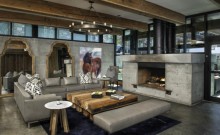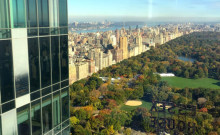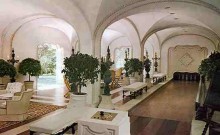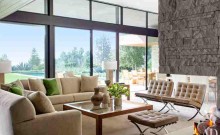Surrounded by vivid Navajo rugs, rustic antiques, and soulful Spanish Colonial artifacts, the actress finds peace and inspiration at Forked Lightning Ranch
House hunting was not on Jane Fonda’s priority list in 2000. Recently separated from her then-husband, media mogul Ted Turner, the actress was living in Atlanta and focusing on future endeavors, which included plans for writing her memoirs (My Life So Far was published by Random House in 2005). But then she was sent a prospectus about a property for sale in New Mexico called Forked Lightning Ranch. The 2,300-acre estate had a three-and-a-half-mile stretch of the Pecos River running through it. Fonda was knowledgeable about ranches—Turner owned more than a dozen—and she recognized that such a feature was rare. It felt like Kismet to her. “When I was married to Ted, I did a lot of fly-fishing, and I knew I would miss it,” she recalls. “And here I was looking at land along a trout river.” Soon enough Fonda, accompanied by her daughter Vanessa Vadim, was flying to Santa Fe in the dead of winter to inspect the place.
“The moment I stepped on the property I knew I was home—its sheer beauty and plaster walls made my hair stand on end,” Fonda says. She was also enchanted by the barn, designed in 1960 by the firm of John Gaw Meem, one of New Mexico’s most influential architects. So with encouragement from her family, Fonda added ranch owner to a long list of credits that also includes activist, fitness expert, author (her latest book, Being a Teen, is out in March), and busy Oscar-winning actress, who last year scored an Emmy nomination for her role on HBO’s The Newsroom in addition to filming the movieThis Is Where I Leave You with Tina Fey and Jason Bateman.
Forked Lightning is where she comes to escape. Adjacent to Pecos National Historical Park, the property is the middle section of what was once a 13,000-acre cattle ranch owned by movie star Greer Garson and her husband Buddy Fogelson. When Fonda first purchased the estate, the only accommodation was a two-bedroom log cabin, which became her base for three years while she constructed River House, an expansive residence with space for her children and their families.
Fonda was interested in re-creating the look of traditional northern New Mexico dwellings—typically rambling ranch homes that have been added on to over the years. River House was given many of the region’s classic architectural features, among them double adobe walls, a pitched tin roof, and a hand-troweled plaster exterior in a sunbaked terra-cotta color. Reclaimed-wood beams were painstakingly collected for the ceilings, while antique doors were procured from dealers in and around Santa Fe. Fireplaces were built from designs found in a seminal book on New Mexican hearths, and bricks in a range of sunset hues were laid down as flooring, another local hallmark. The interior walls received a high-gloss finish—known as diamond-point plaster because of its shine—using a technique perfected by the late Betty Stewart, a noted Santa Fe builder. The house has a rustic, handcrafted look that belies its newness, with elements such as carved-wood chandeliers and oxidized-tin sconces bolstering the impression of age. “When Robert Redford came to visit,” says Fonda, “he thought the house was at least a hundred years old.”
Fonda explored her own design talent as well, devising the beds for both the master suite and Vanessa’s room. And a good deal of the furniture and objects came with the actress, each piece with specific associations to different periods of her eventful life. The elk head over the living room fireplace was Fonda’s quarry from a hunting excursion at Turner’s Flying D Ranch in Montana. As for the guesthouse’s antique French lit de sorcière, or witch’s bed—so named because of the convex mirrors at either end that reflect light when the sun hits them (supposedly warding off evil)—Fonda says, “I found it in a shop in Connecticut when I was filming Stanley & Iris. I had no place for it at the time, but I wanted it. A psychic had once told me she saw light at my head and feet.”
Fonda happens to be an inveterate collector, and the fruits of her passion are present throughout the house: majolica and Roseville pottery, Japanese baskets, California Plein-Air paintings. Most impressive is an extensive series of framed pressed wildflowers, all handpicked, identified, and mounted by the actress herself. For her vast book collection and her stockpile of Navajo rugs, meanwhile, Fonda wanted an upstairs galleria, which was copied from the Santa Fe Public Library.
This interest in art and design is reminiscent of her cousin Millicent Rogers, the style icon who put down roots in Taos, New Mexico, and who has been a great inspiration. “Even though I barely knew her, I feel her presence,” Fonda says. “I feel in some way I am here because of her.” Like the Pecos River that winds through Forked Lightning, Fonda’s life has taken many twists and turns, and for more than a dozen years the ranch has been a personal oasis. “It’s where I healed after my marriage—it’s where I came to understand my life so far,” she says. “I wrote my memoirs here. It has a deep calling.”







